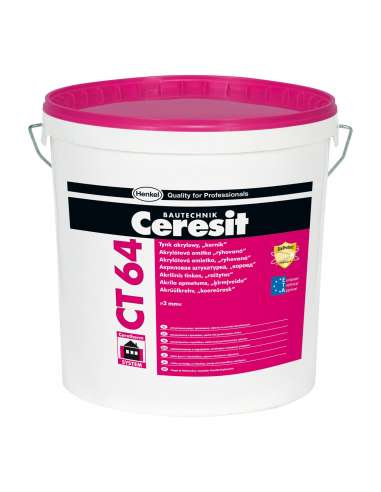- Manufactured in more than two hundred colours
- Ready to use
- Vapour permeable
- Hydrophobic
- Resistant to weather conditions
- Amount required: approx. 2.7 kg/m2
CT 64 is suitable for indoor and outdoor use on walls exposed to high wear: at entrances, in hallways, stairwells, on platforms, window and door reveals. It can be applied and smoothed with metal floats. Sealing component: transparent resins. Filler: coloured grit. Produces a glassy, colourful coat upon setting.
CT 64 can be applied on smooth, carrying, dry and clean substrates free from grease, bitumen, dust and other sub- stances decreasing adhesion:
– cement plasters and lime-cement plasters (age above 28 days, moisture ≤ 4%), concrete (age above 3 months, moisture ≤ 4%) – primed with Ceresit CT 16 paint,
– armoured layers made of Ceresit CT 85 or ZU mortars (age above 3 days), primed with the paint CT 16,
– gypsum substrates (only inside the buildings) with moisture below 1 %, firstly primed with the agent Ceresit CT 17, and then with the paint CT 16 or made of CT 87 "2 in 1" (age above 2 days),
– chipboards, gypsum-fibre boards and gypsum cardboards (only inside the buildings), fixed according to the recommendations of the board manufacturers, firstly primed with the agent CT 17, and then with the paint CT 16,
– strong paint coats (only inside the buildings), with good adhesion to the substrate, primed with the paint CT 16.
Uneven and damaged substrates should be first smoothed and repaired. In case of traditional plasters and concrete substrates, Ceresit CT 29 plaster filler can be used. The existing dirt, layers of low strength, as well as elastic, lime and adhesive paint coatings should be removed. Absorbent substrates should be primed with the agent Ceresit CT 17, and then painted with Ceresit CT 16 paint after minimum 4 hours. It is recommended to use the colour of the paint CT 16 similar to the colour of the plaster. The plaster CT 64 can be applied when the priming paint CT 16 becomes completely dry. The moisture coming from the substrate can cause the destruction of the plaster, therefore one should be assured that the adequate sealing layers have been made in the rooms (places) endangered with constant moisture.
The whole content of the container should be carefully stirred. If the need appears, it is possible to adjust the product consistency to the application conditions by adding a small amount of clean water and mixing again. Use only stainless containers and tools. CT 64 should be evenly applied on the substrate at the thickness of the grain by means of a steel long float held at the angle. Then, it should be given homogenous structure with a plastic long float flatly held. Depending on the type of the float movement: circular, horizontal or vertical it is possible to obtain the structure features resulting from the grain. Do not sprinkle plaster with water! Work should be done on one surface without breaks, keeping the same product consistency. If there is a need to stop working, the self-adhesive tape should be applied along the previously fixed line. Then plaster should be applied, structure formed, and tape torn off with the plaster remaining on it. After a break, the application should be continued from the fixed place (the edge of the previously applied plaster can be protected with self-adhesive tape). Tools and fresh plaster stains should be washed with water, and the hardened plaster remains can be mechanically removed. Plaster renovation should be done by painting with Ceresit CT 42 and CT 44 acrylic paints as well as Ceresit CT 48 silicone paint.
- Model
- CT64
- Usage/Coverage
- grain 2mm - approx. 2.7 kg/sqm
- Size
- 25 kg
- Unit
- bucket


